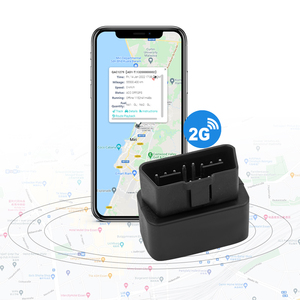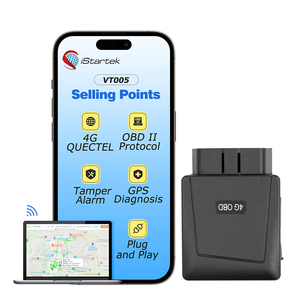(3465 products available)






























































































































































































































OBD 2 GPS is a technology that combines the On-Board Diagnostics (OBD) system with GPS (Global Positioning System) capabilities. It allows access to the vehicle's diagnostic information and real-time location tracking. The OBD 2 GPS provides details about the vehicle's health and performance, such as fuel consumption, engine health, and speed. This information helps track the vehicle's health and make informed decisions to improve driving habits and maintain the vehicle's performance. There are various types of OBD 2 GPS devices;
Compatibility with Vehicles
The OBD2 GPS tracker should be compatible with all vehicles, regardless of their make, model, or year of manufacture.
Real-Time Tracking
Real-time tracking allows users to track the vehicle's location in real-time. It should be accurate and update the location frequently to provide precise information about the vehicle's location.
Geofencing
The OBD2 GPS tracker should have a geofencing feature that allows users to set virtual boundaries on a map. Users can receive alerts when the vehicle enters or leaves a designated area. This feature is beneficial for parents who want to monitor their children's driving or businesses that want to ensure their vehicles stay within a specific region.
Historical Data
The device should store historical data, including the vehicle's past locations and routes. Users can access this information to analyze the vehicle's travel history.
Speed Alerts
The OBD2 GPS tracker should have speed alert capability. Users can set a speed limit, and the device will send alerts if the vehicle exceeds that limit. This feature is useful for ensuring safe driving, especially for young or inexperienced drivers.
Device Size and Design
It should be compact and lightweight, making it easy to plug into the vehicle's OBD-II port without obstructing other functions. Its design should be durable and able to withstand different environmental conditions.
Power Supply
The OBD2 GPS tracker should be powered through the vehicle's OBD-II port without requiring an external power source. It should have low power consumption to avoid draining the vehicle's battery.
Data Security
The OBD2 GPS tracker should have data encryption and secure communication protocols to ensure the user's data and the vehicle's information are protected from unauthorized access and hacking.
Mobile App and Web Interface
Users should access the OBD2 GPS tracker's data and control its functions through an intuitive and user-friendly mobile app or web interface. The app/website should display real-time location, send alerts, and allow users to configure settings easily.
Vehicle Health Monitoring
The OBD2 GPS tracker should monitor the vehicle's health status, such as reading error codes, reporting diagnostic trouble codes (DTCs), and providing information about the vehicle's health and maintenance needs. This feature helps users understand the vehicle's health and take timely maintenance actions.
Maintaining the OBD2 GPS tracker is essential to ensure its optimal performance and accurate vehicle tracking. Here are some common maintenance tips:
Regular Software Updates
Users should check the manufacturer's website regularly to obtain the latest software updates for the OBD2 GPS tracker. Updating the software can improve the device's performance, fix bugs, and add new features.
Device Cleaning
The OBD2 GPS tracker should be periodically cleaned to remove dust, dirt, and debris. Users can use a soft cloth and mild detergent to wipe the device's surface and the OBD-II port to ensure a good electrical connection.
Check the Connection
Users should ensure the OBD2 GPS tracker is securely connected to the vehicle's OBD-II port. A loose or poor connection may affect the device's performance and data accuracy.
Battery Maintenance
If the OBD2 GPS tracker has a built-in battery, users should follow the manufacturer's instructions for battery maintenance and charging. Avoid exposing the device to extreme temperatures, and do not immerse it in water or other liquids.
Data Management
Users should regularly check the data storage of the OBD2 GPS tracker and the mobile app or web interface. Delete unnecessary historical data to ensure the device's smooth operation and free up storage space.
Environmental Considerations
Place the OBD2 GPS tracker in a safe environment inside the vehicle, avoiding exposure to direct sunlight, high humidity, or extreme temperatures. These environmental factors may affect the device's performance and lifespan.
Regular Functionality Checks
Users should periodically check the OBD2 GPS tracker's functionality, including real-time location tracking, alert notifications, and other features. If any issues arise, contact the manufacturer or service provider timely to resolve them.
Wholesalers and retailers need to understand the factors that affect the quality and performance of OBD2 GPS devices. Here’s what to look out for when sourcing GPS trackers for cars with OBD2:
Installing and using an OBD 2 GPS tracker is very simple. Here are the steps:
Plug the OBD II GPS tracker into the port
Firstly, locate the OBD II port in the car. It is very simple to find as it is located under the steering wheel, usually at the driver's side. After locating the port, plug the GPS tracker into the port. Make sure it is firmly connected so that it does not fall off or get loose.
Connect the GPS device to the tracking software
After plugging the device, it automatically connects to the tracking software. This is done by the device creating a secure connection to the tracking software through a cellular network or sometimes a Wi-Fi network.
Download the tracking app
For one to be able to track the vehicle's location, one must download the tracking app. This app can be downloaded on either a tablet, smartphone, or computer. After downloading the app, create an account, and then log in with the credentials that have been created. With this, one will be able to track the vehicle's location in real time.
Set up alerts
After downloading the app and logging in, set up different alerts and notifications. These alerts will keep notifying one of different events. Some events that the alerts will notify one of include speed violations, geofence breaches, and maintenance reminders. These alerts will help track the car's performance and keep the car in good condition.
Q1: What is an OBD2 GPS?
A1: An OBD2 GPS is a device that uses the car's OBD2 port to provide various functions, including GPS navigation, tracking, and diagnostics. It is a versatile tool that combines location services with vehicle information access.
Q2: Does every car have GPS on board?
A2: No, not every car has an OBD2 port. Older cars manufactured before 1996 may not have an OBD2 port. However, most modern cars built after 1996 have an OBD2 port available.
Q3: Can users install an OBD2 GPS themselves?
A3: Yes, it's pretty simple to install an OBD2 GPS. Plug it into the OBD2 port, and it will automatically connect to the vehicle's system. Users don't need any technical skills or special knowledge to set it up.
Q4: What can an OBD2 GPS monitor?
A4: An OBD2 GPS can track the vehicle's location, monitor driving behavior, check vehicle health, and provide real-time alerts. It gives users detailed information about the car and its performance.
Q5: Is an OBD2 GPS accurate?
A5: The OBD2 GPS is very accurate and can track the car's location within a few meters. It uses advanced GPS technology to provide precise information about the vehicle's position and movement.